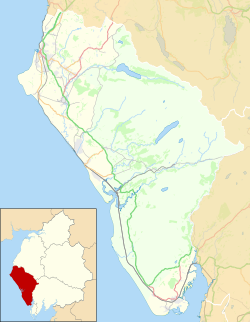| Holmrook | |
|---|---|
 Cottages by the A595 at Holmrook | |
Location within Cumbria | |
| OS grid reference | SD077995 |
| Civil parish | |
| Unitary authority | |
| Ceremonial county | |
| Region | |
| Country | England |
| Sovereign state | United Kingdom |
| Post town | HOLMROOK |
| Postcode district | CA19 |
| Dialling code | 019467 |
| Police | Cumbria |
| Fire | Cumbria |
| Ambulance | North West |
| UK Parliament | |
Holmrook is a linear village in the English county of Cumbria. It lies along the A595 road on the west banks of the River Irt. The B5344 road connects it to Drigg, with its railway station less than two miles to the west.
Contents

Two miles north-east along the Irt valley is Irton Hall, a large mostly 19th-century house which incorporates a 14th-century pele tower. [1]

